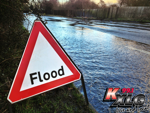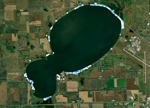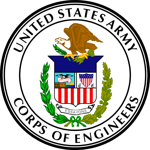{KXLG – Watertown, SD} The Watertown City Council convened a crucial meeting on Monday evening, June 30, 2025, engaging in a comprehensive discussion about long-standing flood control issues with representatives from the U.S. Army Corps of Engineers and the Lake Kampeska Water Project District Board.
Mayor Ried Holien opened the meeting by emphasizing the critical need for a decision on flood control, highlighting the city’s investment of over $ 1 million in research by the Corps of Engineers to date. He emphasized that the council is united in its commitment to finding a solution, acknowledging that the federal government’s financial involvement is essential for any viable project.
“We are at a point where we have to make some tough decisions,” Mayor Holien stated. “Our commitment has been shown by the dollars and the time that we have spent. My concern is that if we do not act right now, nothing will be done for flood control for all of Watertown and Lake Kampeska in my lifetime.”
Army Corps of Engineers Presents Alternative 8
Drew Miller, Chief of Planning with the Omaha District Corps of Engineers, and Sarah Miller, Project Manager for the US Army Corps of Engineers, presented Alternative 8 as their recommended plan. This proposal includes a levee and seawall on the east side of the Big Sioux River, a widening of the overbank channel, and modifications to the river weir.
City Engineer Justin Petersen clarified that the proposed levee system would range in height from two to four feet. The primary modification to the weir would involve removing one stop log under certain conditions, specifically when the lake level exceeds a specific elevation. This action, which occurs approximately 30% of the time, is projected to reduce the lake level by about 0.8 feet throughout a couple of months, allowing floodwaters to bypass the lake more quickly and providing additional storage within Lake Kampeska.
Sarah Miller noted that while previous plans with a benefit-cost ratio above one are typically approved, all current alternatives fall below that threshold…
Jeff, Technical Lead for the Corps of Engineers, added that Alternative 8 could remove 576 structures from the 1% floodplain, compared to 280 structures if the lake level is not lowered. The overall annual benefit of Alternative 8 is estimated to be approximately $993,000.
Lake Kampeska Board Raises Concerns
Brad Johnson, a board member of the Lake Kampeska Water Project District, expressed skepticism about the proposal, particularly concerning the modification of the weir and its potential impact on Lake Kampeska. He reiterated the board’s long-standing concerns about using the lake as a “retention bladder” in the spring and lowering it in the fall, along with potential water quality issues…
Johnson also highlighted the substantial estimated cost of the project, at $37.8 million, with the city of Watertown’s share projected to be roughly $13 million and the federal government contributing approximately $24.5 million. He emphasized the need for greater transparency regarding the project’s details and costs, particularly for the general public outside of the lake area.
Towards the end of the meeting, Councilman Lynn Jurrens made a commented on the potential of state funding and a bond:
“So while I would like to say yes today, I think this discussion has been very, very beneficial because while they’ve done a lot of work, we learned something new that they’re willing to give a chance at today. And that is get rid of the sediment out of the water before it flows in. Or at least analytically, there’s a chance to get that included in this. And I kind of looked around at some of the reactions to that. I’m not a, you know, a room reader at all, but I just saw some heads nodding that there’s some hope that that can really be a benefit to justify not only 7 million of a bond that we would have to take out. That’s if the state says they want to go ahead with their six and a half, 7 million. That’s if the feds say it’s worth 37 total million of taxpayer money to do this.”
Responding to the “sacrificial lamb” analogy used by Mr. Johnson, Mayor Holien sought clarification. Mr. Johnson explained that artificially lowering the lake level makes it more vulnerable to sedimentation during flood events, thereby shortening its lifespan. He suggested that mitigation efforts, possibly funded by the city, should be considered to address the long-term impact of increased sedimentation…
Sedimentation Management and Dredging Potential
Discussions continued on the complex issue of sedimentation in Lake Kampeska. City Engineer Justin Petersen acknowledged that the Corps’ current understanding of sediment flow primarily relies on a 1998 report and that new water sample data would be crucial for a more accurate analysis of how proposed changes would affect the lake. Brad Johnson confirmed that the Lake Kampeska Water Project District Board possesses more recent data, which they are willing to share…
The potential for dredging as a mitigation strategy for sediment accumulation was also explored. Sarah Miller of the Corps of Engineers presented rough estimates for dredging the area between the two weirs near the lake’s inlet. “If we dredged somewhere around 21,000 cubic yards, it’s probably going to be about $1,000,000 cost,” Miller explained, noting this volume equates to roughly 2,100 dump trucks. She suggested this could address about 20 years of accumulation based on 1998 data, but stressed the need for current water samples to confirm these figures. The Corps indicated that if such dredging could be justified as a floodwater storage benefit, it might be included in the federal cost-sharing.
Dry Dam Project Deemed Not Viable
The discussion briefly touched on the concept of a dry dam north of Watertown, formerly known as the Mahoney Creek Dam, a solution that had been previously considered. Drew Minert of the Corps of Engineers stated that the project was not politically viable…
However, it is deemed the ideal technical solution.

Federal Funding Hinges on City’s Letter of Support
Mayor Holien reiterated the critical need for a letter of support from the city to advance the project within the Corps of Engineers by November…
A significant update was announced, stating that disaster supplemental funding has been secured, covering the city’s previous share of over $300,000 in costs. This means “no more money that’s going to be needed from the city” in the short term, a development met with appreciation by the council.
Path Forward: Collaboration and Continued Dialogue
The Corps’ final report is scheduled for release in August. The Corps expressed its willingness to engage further with the city and the lake board to address remaining questions and refine the plan, as further discussion is necessary…
Mayor Holien concluded the meeting by emphasizing the gravity of the decision, acknowledging the community’s mixed feelings. “I do believe we need to do something,” he affirmed, stressing that inaction would lead to continued flooding and further degradation of the lake. He expressed a desire for a solution that avoids significant harm to Lake Kampeska while providing essential flood benefits.
Stream the entire meeting below:
https://www.nwo.usace.army.mil/Missions/Civil-Works/Planning/Planning-Projects/Watertown-SD/
Previous stories:
{KXLG – Watertown, SD} Tonight, several citizens from the Watertown community packed into the Watertown Event Center, including some Council a…
{KXLG – Watertown, SD} The City of Watertown, in partnership with the U.S. Army Corps of Engineers will hold a public meeting on Tuesday, Sept…





